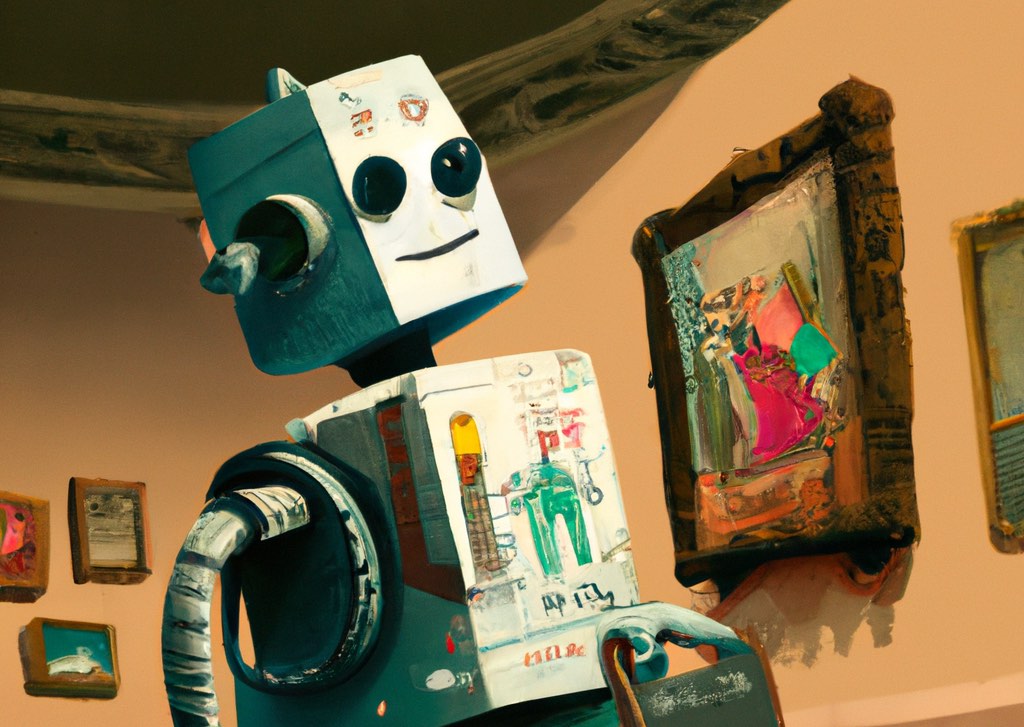In this series of articles, we’ll be examining art styles from the history of Western Art, and documenting how effectively the AI art tool DALL·E can mimic them.
To make comparisons as straightforward as possible, we’re using the same two subjects for every style. This makes it easier to focus on the style shifts themselves.
That said, many art styles are closely associated with a certain kind of subject matter (saintly angels, lush natural landscapes, human faces) so you may get better results if your prompt has subject-style synergy. (We’ll explore this in a later update!)
Finally, this series only focuses on 2D art, like paintings, murals and drawings, rather than sculptures, pottery or the like. (This is because we’d also need to define how the 3D objects are photographed/depicted, adding another layer of complexity.) We’ll take a tour through some of those possibilities in a future article.

DALL·E x Western art history – prompt guide
Part 1: Ancient & Medieval art
🔜 Part 2: Renaissance & Mannerist
🔜 Part 3: Baroque to Neo-classic
🔜 Part 4: 19th century art styles
🔜 Part 5: Modern & contemporary art styles
A few tips on getting the results you want:
🙇🏻♂️ Go back to the source: I’m no art historian – so you’ll have to judge how closely the specimens below match their given style. As a disclaimer, most of the examples below were generated from a single request, with no further fine-tuning, so with only a little effort, you should be able to do surpass them! Refer back to original materials from the eraand you may be able to derive more accurate results.
🖼 Double-down on style prompts: prompting for an era or culture, like ‘Ancient Rome’, is a good start, but to amplify your request, try including related terms such as year, location or artist, such as ‘Ancient Roman painting, a fresco from 200 BCE discovered in Pompeii.’
🧹 Clean it up: if the results seem too ‘scuffed up’, try using terms you might read in an art textbook, like ‘well-preserved’, ‘outstanding example of’, ‘in perfect condition’, ‘careful restoration.’
👩🏼🚀 Boost the subject: if your desired output is an anachronism (like astronauts in Ancient Egypt) DALL·E might lose confidence in making the astronauts very ‘astronaut-y’, because it considers the two concepts so divergent. As a result, your astronauts might end up looking more like regular Egyptians. You can counteract this by being more specific and tautological in your subject language, so: ‘astronauts, in space, wearing white spacesuits with helmets.’
1. Cave painting
The oldest surviving art created by humans dates back 43,000 years. Read about cave paintings on Wikipedia.


2. Detail from Ancient Egyptian mural
Whoa there, Pharoah! ‘Ancient Egyptian art’ actually covers over 6,000 years of history, up to 400 CE – for comparison, we’re only 1600 years away from that! It obviously contains multitudes. But ask for Ancient Egyptian art straight-up, and this is what you get.


3. Ancient Egyptian papyri
Some Ancient Egyptian works are on papyrus, like The Book of the Dead.


4. Fayum portrait
Although Ancient Egypt commonly brings to mind long murals of unusually-arranged figures, the civilisation also gave rise to this fine painting style. Also known as ‘mummy portraits.’


5. Decorative Minoan mural
Ah, the Minoans, famous for their… things, and stuff. Art from this Mediterranean culture covers 3000 to 1100 BC. Find out more about their art, so you too can boast: ‘Minoans? Me know ’em!’


6. Ancient Roman mosaic
Tile, and the world tiles with you. Ancient Rome was well known for images constructed from tessera, with surviving examples from walls and floors. Read about Ancient Roman mosaics on Wikipedia.


7. Ancient Roman painting
Apart from the dancing astronauts, and the cat in the sunglasses, what did the Romans ever do for us? See the Met Museum’s guide to Roman painting.


9. Detail from Nuremberg Chronicle
A famous document from 1493, full of illustrations of the world. Read about it here.


10. Byzantine icon
Halo halo halo, what have we here then? Byzantine art comprises the body of Christian Greek artistic products of the Eastern Roman (Byzantine) Empire. So sayeth Wikipedia.


11. Early Christian icon
Holy moly. When you absolutely positively need a circle around your subject’s head, look no further than the styles of early Christian icons. Read more.


12. …from lavish, gilded Codex
The codex was the pricy predecessor of the modern day boo – manuscripts created by scribes on sheets of vellum and, most relevant to our needs, often lusciously illustrated, or ‘illuminated.’ Read all about ’em.


13. Mozarabic art
Let’s mosy on through art history with some Mozarabic Art, the art of the Iberian Peninusla (site of modern day Spain) back when Arabs ran the show in the 8th – 11th centuries. See more.


14. …detail from Bayeux Tapestry
Epic stories on embroidered cloth from 11th century Europe. Now available in DALL·E. (Take a look at the original Bayeux Tapestry.)


15. Romanesque painting
European art from 1000 AD to 1200 AD. Read the Wikipedia article.


16. …from a bestiary in the Middle Ages
Bestiaries were compendiums of beasts, popular in the Middle Ages.


17. International Gothic painting
A period of Gothic art dating from the 14th and 15th centuries. Here’s the lowdown.


End of part 1.








